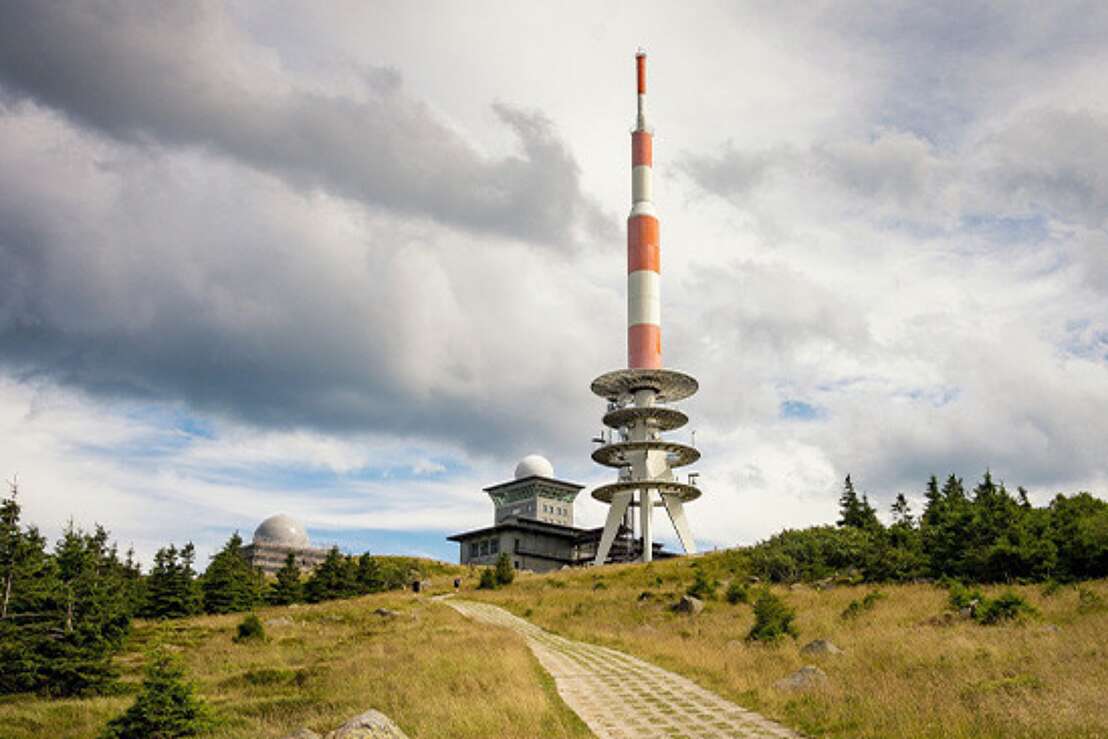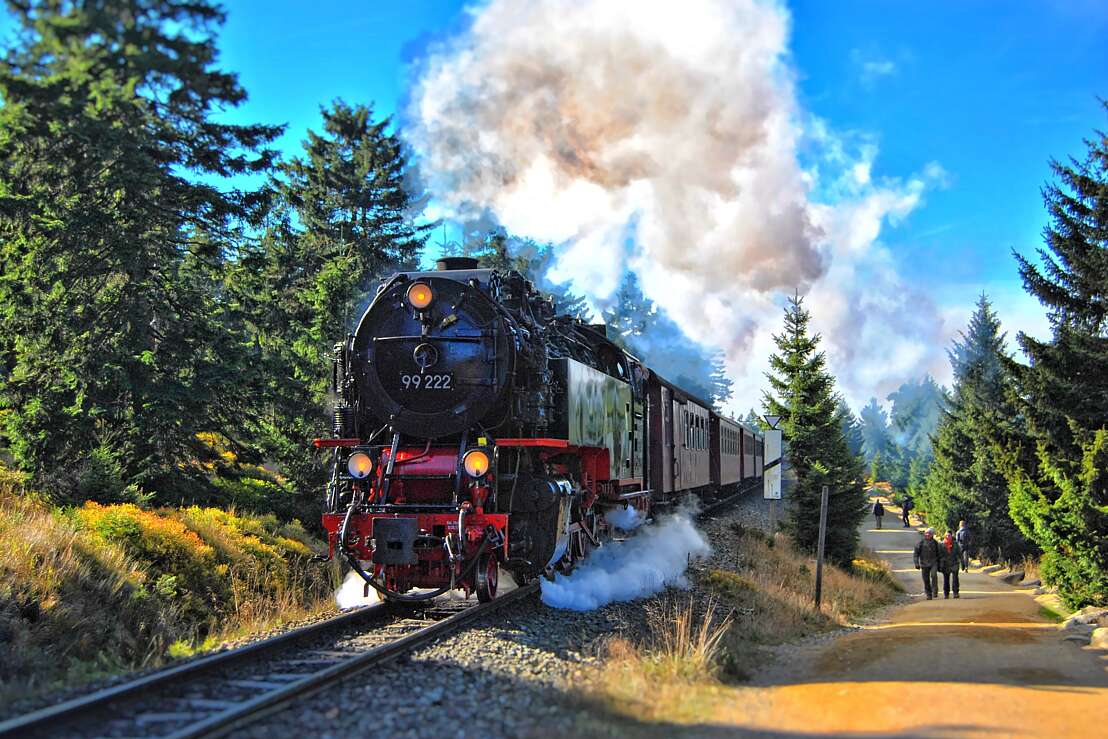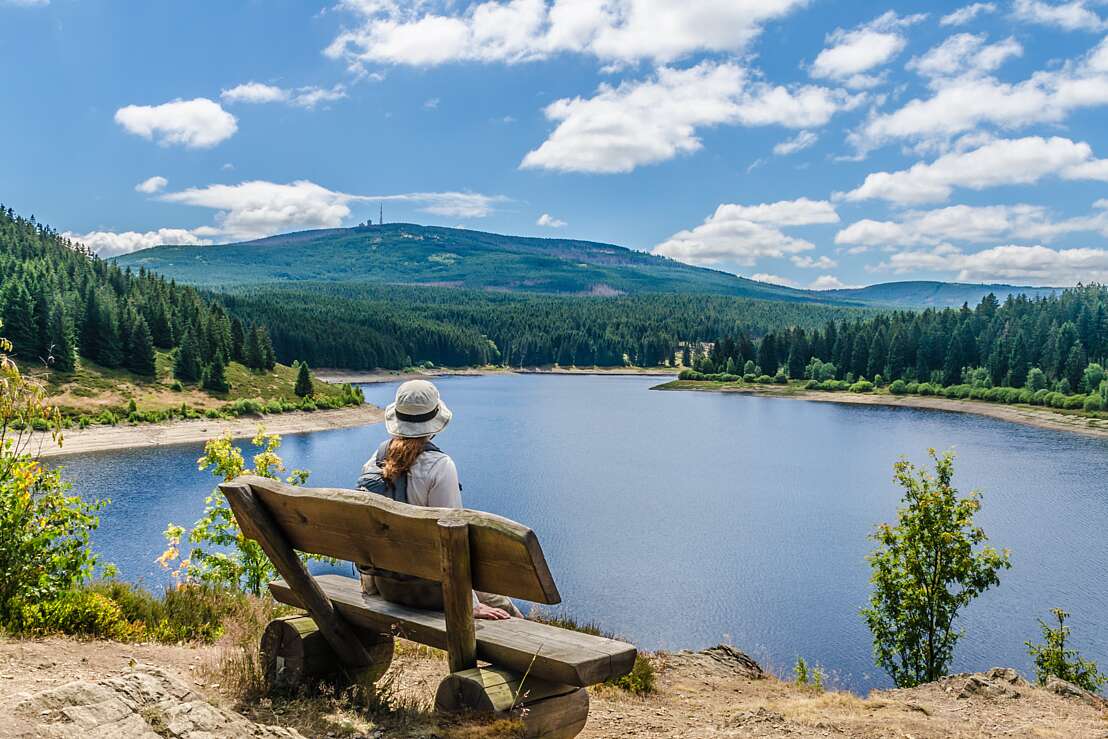Brocken
Northern Germany's highest mountain
Excursion destinationsHarzspots Vacation planner
| Name | Date |
|---|
Visible from afar, the landmark of the Harz Mountains rises into the sky amidst the magical mountain landscape. We are talking about the well-known Brocken in the Harz National Park, which at 1,141 metres is not only the highest mountain in the Harz Mountains, but also in the whole of northern Germany, making it a popular excursion destination for tourists as well as local residents. It is located in the federal state of Saxony-Anhalt, more precisely in the Upper Harz in the Schierke district of the town of Wernigerode. The border with the federal state of Lower Saxony runs around two kilometres from the summit. At the highest level, the Brocken plateau, hikers and cyclists can expect a wonderful and unforgettable 360° view of the Harz Mountains. On a clear day, you can see as far as the Köterberg in Weserland, the large Inselsberg in Thuringia and the Petersberg on the Saale from the summit of the Brocken. On the flat plateau of the Brocken, which is also popularly known as Blocksberg, there are several buildings as well as a 123 metre high radio tower next to the weather station of the German Weather Service, which also characterises the silhouette of the mountain and is clearly visible from afar.
Facts, figures and data:
- 1141 m above sea level
- approx. 300 foggy days per year
- 10.3 degrees Celsius ⌀ highest daily temperature in July
- 178 days of snow cover on the summit
- Approx. 2 million visitors per year
- 263 km/h as the highest measured wind speed
Climate and weather conditions
Due to the high altitude (1,141 m) of the Brocken summit above the natural tree line, you should be prepared for very sudden changes in weather and sometimes extreme weather conditions when visiting. High levels of precipitation, low temperatures and strong gusts of wind clearly distinguish the climatic conditions from the surrounding Upper Harz region. Even when the sun is shining, strong temperature fluctuations can await you at the top, which is why warm and weatherproof clothing is always recommended for the ascent. In addition to frequent storms on the summit plateau, the clouds of fog (approx. 300 foggy days per year) give the Brocken its mystical glamour. The sub-alpine climate that prevails here can best be compared to Icelandic climatic conditions, whereby the temperatures are usually very slow to climb into the double-digit range even in midsummer and the summit is almost permanently covered by a thick blanket of snow in winter. Apart from the strongly fluctuating temperatures, you should also be prepared for strong gusts of wind, as gale-force winds with wind speeds of up to 260 km/h prevail on the Brocken 100 days a year. Apart from the rather harsh weather conditions, there are pleasant temperatures full of sunshine on the Brocken on around six to seven days a year, which allows for a breathtaking panoramic view of the surrounding landscape stretching over 200 kilometres.
Flora and fauna
The flora and fauna of the Brocken, like the weather, are comparable to those of the Alpine highlands or northern Scandinavia. Due to the high altitude above the natural tree line, only small spruce trees can be found here. The high altitude natural area is dominated by over 1,000 high mountain plants, including the dwarf shrub heath. Other typical plants to be found on the Brocken are the small alpine cowbell, lady's mantle, bloodroot and the alpine flat-leaved clubmoss. Cottongrass, sundew and dwarf birch also thrive on the raised bogs. To gain further insights into the fauna of the Brocken, a visit to the Brocken Garden, founded in 1890, is highly recommended. Here, national park staff look after the preservation of the diverse fauna and offer regular, informative guided tours. In addition to typical plants from the Brocken, plants from other countries and regions are also on display here.
Not only the numerous plant species, but also some animal species have adapted to the rather unusual living conditions at this altitude. Birds such as the meadow pipit and the ring ouzel, wood lizards, frogs, beetles, butterflies and bats can be found here.
History: The Brocken over the course of time
According to records, the first house on the Brocken was built in 1736 by the then owner Count Christian Ernst zu Stolberg-Wernigerode. To this day, the so-called cloud house made of stone serves to protect hikers. The first inn on the Brocken was finally opened in the summer of 1880, but was destroyed during the Second World War. In 1899, the Brocken railway was put into operation for the first time for the journey to the summit, after the last construction section between Schierke and the Brocken was completed in 1898. During the division of Germany, the Brocken was considered to be in the border area of the GDR due to its location and was therefore not accessible to civilians as a restricted military zone until 1989. The Brocken railway also ceased operations completely at this time. It was only after reunification and the fall of the Berlin Wall that people were able to climb the Brocken again on 3 December 1989 with the opening of the gate to the plateau, whereupon the Brocken Railway was also put back into operation in 1991. In the period that followed, the Brocken plateau was extensively restored. The Brockengarten was reopened and the Brockenhaus was remodelled.
Legends and myths surrounding the Brocken
The Brocken has captivated people for centuries with its magical aura. It is therefore hardly surprising that numerous myths and legends surround the highest mountain in northern Germany. Numerous ghosts, witches and devils are said to haunt the summit.
The so-called "Brocken ghost" in particular caused fear and terror in earlier times. Today, however, the mystery is easily explained by simple physics. More precisely, it is an optical illusion that occurs due to the dense fog at the lofty heights of the Brocken. Hikers can often see their own shadows in the dense clouds surrounded by a colourful glow of light. As every single drop of vapour water reflects the shadow, it appears much larger than a conventional shadow. What is particularly creepy is that the shadow seems to float and appears to move when you stand still.
The symbolic figure of the witches is also known for the Brocken and the entire Harz Mountains. According to legend, every year on Walpurgis Night on 30 April, the witches gather at the witches' dance floor near Thale to set off together to the Brocken and marry the devil. Every year, the mystical Walpurgis Night attracts numerous disguised visitors to the Brocken in droves to relive the ancient tradition.
The Harz Mountains, and the characteristic Brocken in particular, have always inspired the imagination of famous poets and thinkers. Heinrich Heine, for example, wrote a poem about his trip to the Harz Mountains and also made an entry in the Brocken Book. Goethe also thematised the Brocken and Walpurgis Night in his world-famous work "Faust". He himself climbed the Brocken three times, first in the winter of 1777 and encountered the aforementioned Brocken ghost himself.
Routes up the Brocken
From numerous hikes and cycle tours to guided Segway tours, there are many ways to climb the Brocken. However, you won't get far here by car, as motorised vehicles other than e-bikes and Segways are not permitted. However, if you don't want to exert your own muscle power on the way up, you can take a ride on the historic Brocken railway operated by the Harz narrow-gauge railway, which is an experience in itself. The Brockenbahn offers various access points along the route, including in Schierke, and travels comfortably through the beautiful landscape. The entire route of the steam locomotive runs from Wernigerode via Drei Annen Hohne to the Brocken. The old steam locomotives take tourists and holidaymakers up to the summit in a comfortable and above all romantic way with 3.5 tonnes of coal and 700 hp of power. Especially in winter, the thick blanket of snow and the old steam locomotive make for a particularly idyllic sight. It is even possible to travel by horse-drawn carriage. On summer days, a covered wagon with two horsepower takes you from Schierke up to the summit in around two hours.
Arriving at the Brocken summit
At the summit, you will be greeted by a wonderful view that will immediately make you forget the effort of the climb. If you get here, you should definitely not leave without taking the famous photo in front of the Brockenstein, which you are sure to remember for a long time to come. If you like, you can continue your hike up here along the former Brocken Wall on a 1.5 kilometre circular hiking trail. Guided hikes lasting around an hour are also offered regularly.
Here is an overview of what awaits you on the Brocken plateau:
- Summit circular trail
- Brocken railway station
- Brocken garden
- Brockenhotel with viewing platform
- Brockenhaus/Museum (National Park Visitor Centre)
- Brocken Clock & Brockenstein
- Cloud house
- Devil's Pulpit & Witches' Altar
- Weather station
If you prefer to take the Brocken railway for a romantic and relaxed ascent instead of walking or cycling, you will arrive directly at the Brocken railway station with its restaurant and souvenir shop. The aforementioned Brocken Garden offers you an overview of different plant species from the Brocken and around the world from mid-May to mid-October.
The Brockenhotel is also well worth a visit, as it is the highest hotel in northern Germany and offers a weather-protected viewing platform from which you can enjoy the view even in bad weather.
The Brockenhaus or museum offers an interesting exhibition on three floors about the Brocken and the Harz National Park on flora and fauna, weather conditions, climate data and the historical use and development of the Brocken.
The Brockenstein, a massive boulder, marks the highest natural point of the Brocken. It is located directly on the summit plateau, which is reminiscent of the face of a clock, earning it the nickname Brocken Clock.
The Wolkenhäuschen, the first known building on the Brocken that has survived to this day, once stood isolated on the summit. Today it is surrounded by other buildings such as the Brockenhotel and the Brockenhaus.
The Devil's Pulpit and the Witches' Altar, both similar rock formations, are located on the summit of the Brocken. For reasons of nature conservation, access to this area is prohibited.
The Brocken weather station, which attracts around 1,000 visitors a year, is the most visited station of its kind in Germany. Since the beginning of 2020, automatic measurement technology has taken over the work of the human weather observers, which was previously carried out by seven employees around the clock.
Harzspots gives you the
Komoot Harz Region Package for free!
Use our voucher from the Outdoor Navigators Komoot and get the „"Harz Regions Package“ free of charge. From now on you can get to know all hiking and cycling routes digitally and, if you wish, also voice-guided!




